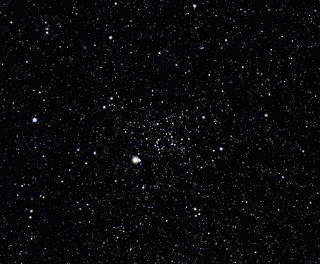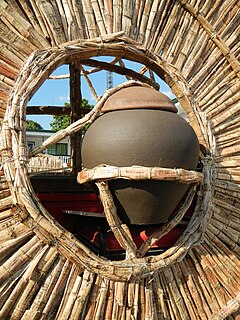
The giant panda, also known as panda bear or simply panda, is a bear native to south central China. It is easily recognized by the large, distinctive black patches around its eyes, over the ears, and across its round body. The name "giant panda" is sometimes used to distinguish it from the unrelated red panda. Though it belongs to the order Carnivora, the giant panda's diet is over 99% bamboo. Giant pandas in the wild will occasionally eat other grasses, wild tubers, or even meat in the form of birds, rodents, or carrion. In captivity, they may receive honey, eggs, fish, yams, shrub leaves, oranges, or bananas along with specially prepared food.

The red panda is a mammal native to the eastern Himalayas and southwestern China. It is listed as Endangered on the IUCN Red List because the wild population is estimated at fewer than 10,000 mature individuals and continues to decline due to habitat loss and fragmentation, poaching, and inbreeding depression.

The Stingray Nebula is the youngest known planetary nebula (PN). The Stingray is located in the direction of the southern constellation
Ara, and is located 18,000 light-years away. Although it is some 130 times the size of the Solar System, the Stingray Nebula is only about 1/10 the size of most other known planetary nebulae. Forty years ago it was still a protoplanetary nebula in which the gas had not yet become hot and ionized. In a Nature article, Bobrowsky et al. described how the Hubble observations revealed a 17th-magnitude companion to the Stingray's 15th-magnitude central star. The image of the Stingray Nebula shown here shows how the outer shells of gas are collimating the continuing outflow of gas from the central star—an important observation, as the process of how these outflows become collimated has not been well understood.

Monthly Notices of the Royal Astronomical Society (MNRAS) is a peer-reviewed scientific journal covering research in astronomy and astrophysics. It has been in continuous existence since 1827 and publishes letters and papers reporting original research in relevant fields. Despite the name, the journal is no longer monthly, nor does it carry the notices of the Royal Astronomical Society.
V1494 Aquilae or NOVA Aquilae 1999 b was a nova which occurred in 1999 in the constellation Aquila and which reached a brightness of 4.0 mag.

Panda diplomacy is China's use of giant pandas as diplomatic gifts to other countries. The practice existed as far back as the Tang Dynasty, when Empress Wu Zetian (625–705) sent a pair of pandas to the Japanese emperor.
Braj Basi Lal, better known as B. B. Lal, is an Indian archaeologist. He was the Director General of the Archaeological Survey of India (ASI) from 1968 to 1972 and has served as Director of the Indian Institute of Advanced Studies, Shimla. Lal also served on various UNESCO committees.

The Madras Observatory was an astronomical observatory which had its origins in a private observatory set up by William Petrie in 1786 and later moved and managed by the British East India Company from 1792 in Madras. The main purpose for establishing it was to assist in navigation and mapping by recording the latitude and maintaining time standards. In later years the observatory also made observations on stars and geomagnetism. The observatory ran from around 1792 to 1931 and a major work was the production of a comprehensive catalogue of stars.

The Australian Transport Safety Bureau (ATSB) is Australia's national transport safety investigator. The ATSB is the federal government body responsible for investigating transport-related accidents and incidents within Australia. It covers air, sea and rail travel. The ATSB is an independent Commonwealth Government statutory agency, governed by a Commission and is separate from transport regulators, policy makers and service providers.
HD 126200 is a blue dwarf star in the northern constellation of Boötes. It has been identified as an Algol-type eclipsing binary, although subsequent observations do not confirm this.

U Orionis is a Mira-type variable star in the constellation Orion. It is a classical long period variable star that has been well observed from the United Kingdom for over 120 years.

The Pachmarhi Telescope Array or Pachmarhi Array of Cerenkov Telescopes (PACT) is an array of 24 telescopes for gamma-ray astronomy. It is located at Pachmarhi in Madhya Pradesh, India. It is operated by the Tata Institute of Fundamental Research.
The Astronomical Society of India (ASI) is an Indian society of professional astronomers and other professionals from related disciplines. It was founded in 1972, with Vainu Bappu being the founder President of the Society, and as of 2010 has a membership of approximately 1000. Its registered office is at the Astronomy Department, Osmania University, Hyderabad, India. Its primary objective is the promotion of Astronomy and related branches of science. It organises meetings, supports and tries to popularise Astronomy and related subjects and publishes the Bulletin of the Astronomical Society of India.
The President of the Royal Astronomical Society chairs the Council of the Royal Astronomical Society (RAS) and its formal meetings. They also liaise with government organisations, similar societies in other countries, and the International Astronomical Union on behalf of the UK astronomy and geophysics communities. Future presidents serve one year as President Elect before succeeding the previous president.

NGC 1245 is an open cluster in the constellation Perseus. It was discovered by William Herschel in 11 December 1786. It is located 3° southwest of alpha Persei and can be spotted with 10x50 binoculars. The cluster is nearly 1 billion years old. NGC 1245 has about 200 members the brightest of which are of 12th magnitude. The cluster shows evidence of mass segredation and it is possible that it has lost its lower mass members. Lying at a distance of 3kpc, the cluster is estimated to be 27 light years across.
Pan Pan was a male giant panda who was resident at the Giant Panda Protection and Research Centre in Chengdu, China. At the time of his death, he was the oldest male giant panda in captivity. The oldest living giant panda in captivity at the time of Pan Pan's death was Basi a female giant panda who was then 37.
Vijay Kumar Kapahi was an Indian astrophysicist and the director of the National Centre for Radio Astrophysics, an autonomous division of Tata Institute of Fundamental Research. Known for his research on radio galaxies, quasars and observational cosmology, Kapahi was an elected fellow of all the three major Indian science academies – Indian Academy of Sciences, Indian National Science Academy and National Academy of Sciences, India – as well as of the Maharashtra Academy of Sciences. The Council of Scientific and Industrial Research, the apex agency of the Government of India for scientific research, awarded him the Shanti Swarup Bhatnagar Prize for Science and Technology for his contributions to physical sciences in 1987.

NGC 2539 is an open cluster in the constellation Puppis, located at the north edge of the constellation. It was discovered by William Herschel on January 31, 1785. It is a moderately rich cluster and with little central concentration, with Trumpler class II1m.













